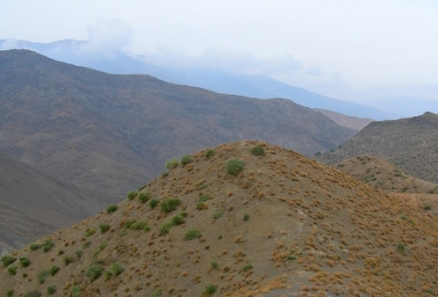Mediterranean High Atlas juniper steppe
The Mediterranean High Atlas juniper steppe is an ecoregion covering the highest elevations of central Morocco. Spanning a land area of approximately 6320 square kilometres, around thirty percent of the ecoregion is forested. Berber tribesmen have inhabited the central part of the ecoregion for at least two millennia. There is an assortment of lifeforms present in this harsh environment of rocky slopes and mostly arid land; however, there is a rich assortment of some taxa such as reptiles that have adapted to these conditions.
In the eastern portion of the ecoregion Atlasaurus remains have been recovered, which ancestral dinosaur thrived here 180 million years before present; this taxon is thought to be a predecessor ot the New World Sauropoda species.
Contents
Location and climate
 Mediterranean High Atlas juniper steppe ecoregion. Source: World Wildlife Fund The ecoregion lies along the middle and upper slopes of the High Atlas Mountains in Morocco; both the mountain range and the ecoregion have the same southwest to northeast axis. The ecoregion is comprised of several disjunctive elements, generally associated with the higher portions of the High Atlas Range. The city of Marrakech lies just north of the ecoregion on the plain below, while the smaller remote city of Quarzazate lies on the southern plain below the High Atlas.
Mediterranean High Atlas juniper steppe ecoregion. Source: World Wildlife Fund The ecoregion lies along the middle and upper slopes of the High Atlas Mountains in Morocco; both the mountain range and the ecoregion have the same southwest to northeast axis. The ecoregion is comprised of several disjunctive elements, generally associated with the higher portions of the High Atlas Range. The city of Marrakech lies just north of the ecoregion on the plain below, while the smaller remote city of Quarzazate lies on the southern plain below the High Atlas.
Most winds arrive from the Atlantic Ocean, which lies not far from the western part of this ecoregion. In the winter this airflow brings moist air, rainfall, and snowfall, comprising most of the precipitation that the High Atlas receives. The highest point in the High Atlas Range is Mount Toubkal with an elevation of 4100 metres. The snowpack in the High Atlas is vital for maintaining river flow in warmer months, which sustains the Draa River and other watercourses that nourish the agriculture and sustain human populations at lower elevations, where summer rainfall is scant.
Geology
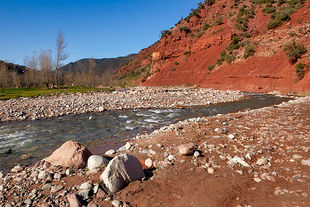 Ourika River, High Atlas Range, Morocco. Source: Nino Verde The western end of the ecoregion closest to Agadir holds a massif composed of Cretacesous and Jurassic elements eroded into deep river cut valleys. This western part of the range includes the Ourika River Valley.
Ourika River, High Atlas Range, Morocco. Source: Nino Verde The western end of the ecoregion closest to Agadir holds a massif composed of Cretacesous and Jurassic elements eroded into deep river cut valleys. This western part of the range includes the Ourika River Valley.
The central part of the ecoregion is characterised by a chalk mass, and includes elevated plateaus, box canyons and river gorges. The highest peak in the central ecoregion is Jbel Mgoun, which rises to 4069 metres.
The eastern part of the ecoregion sits on an expansive plateau, from which the Moulouya River rises. This part of the ecoregion contains high altitude oases near Jbel Ayachi, Jbel Saghro and Jbel Sirwa. The eastern element of the ecoregion is characterised by the Tamlelt formation, the northern portion of which contains its highest peak, Jbel Ayachi (3748 metres).
Vegetative assemblies
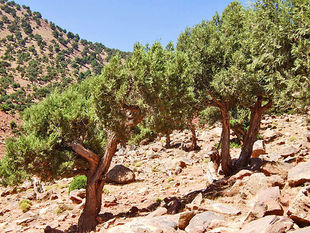 Stand of Juniperus thurifera var africana, High Atlas near Imlil, Morocco. Source: Graham Racher For the lowest sub-alpine reaches (generally defined as 1300 to 1500 metres above mean sea level) of the ecoregion several herbacious species are notable including legumes of the genus Onobrychis; for example, Onobrychis cornuta is an important native forage plant, but it is quite susceptible to the overgrazing that has been rampant in the last half century. O. cornuta has a long taproot, but it re-establishes only slowly after overgrazing episodes. Cretan Barberry (Berberis cretica) is a dominant thorny shrub in this sub-alpine zone that extends up to about 2100 metres in elevation.
Stand of Juniperus thurifera var africana, High Atlas near Imlil, Morocco. Source: Graham Racher For the lowest sub-alpine reaches (generally defined as 1300 to 1500 metres above mean sea level) of the ecoregion several herbacious species are notable including legumes of the genus Onobrychis; for example, Onobrychis cornuta is an important native forage plant, but it is quite susceptible to the overgrazing that has been rampant in the last half century. O. cornuta has a long taproot, but it re-establishes only slowly after overgrazing episodes. Cretan Barberry (Berberis cretica) is a dominant thorny shrub in this sub-alpine zone that extends up to about 2100 metres in elevation.
At the next higher elevations (from about 1500 to 2500 metres in altitude) the Atlantic Cedar (Cedrus atlantica), European Black Pine (Pinus nigra) and Algerian Oak (Quercus canariensis) are dominant trees up until about elevation 2200 metres, yielding to progressively greater occurrences of Spanish Cedar (Juniperus thurifera var africana). Riparian and oasis locales support a variety of willow, hawthorn and oleander species.
At yet higher altitudes alpine meadows take prominence, intermixed with scree slopes at the highest topographic elements. Even on the sparse rocky talus areas cushion plants are often in profusion.
Faunal characteristics
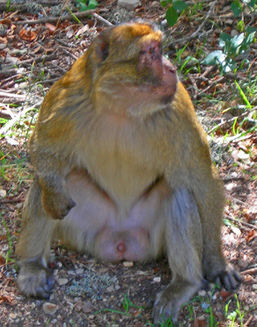 Barbary Macaque sentinel, Atlas Mountains, Morocco. @ C.Michael Hogan There are 158 vertebrate species found in the Mediterranean High Atlas juniper steppe ecoregion. While this number may appear low, it is actually high for such a small land area ecoregion, and it is also respectably large compared with other ecoregions in North Africa. There is a particularly diverse reptilian fauna present.
Barbary Macaque sentinel, Atlas Mountains, Morocco. @ C.Michael Hogan There are 158 vertebrate species found in the Mediterranean High Atlas juniper steppe ecoregion. While this number may appear low, it is actually high for such a small land area ecoregion, and it is also respectably large compared with other ecoregions in North Africa. There is a particularly diverse reptilian fauna present.
Atlas Aoudad (Ammotragus lervia lervia) is a Barbary Sheep subspecies that is endemic to this ecoregion, although its range has been severely diminished from historic levels, due to poaching and habitat loss. A population of the Endangered Barbary Macaque (Macaca sylvanus) is found in the High Atlas. A small population of Barbary Leopard (Panthera pardus panthera) is thought to be relict in the High Atlas. The Atlas Red Fox (Vulpes vulpes atlantica) occurs only in the Atlas Mountains and in Mila Province, Algeria. Common Jackal are some of the other larger mammals found in the ecoregion.
A number of reptiles are found in the ecoregion including the Algerian Fan-fingered gecko (Ptyodactylus oudrii), which is found only in the Moroccan Atlas Mountains ranging to the Atlas Saharien Mountains in Algeria; this gecko occurs up to elevations of 2600 metres. A more widely occurring reptile found here is the Algerian Sand Lizard (Psammodromus algirus), which is found not only on the lower elevations of Morocco, but throughout much of North Africa and limited parts of southern Europe. The Mountain Viper (Vipera monticola) is endemic to the High and Middle Atlas ranges and occurs up to elevations of 4000 metres. A severely restricted endemic to the ecoregion is Andreansky's Lizard (Teira andreanskyi), which is found only in the High Atlas at elevations of 2400 to 3800 metres above sea level.
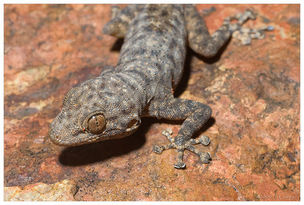 Algerian Fan-fingered Gecko, near endemic to the HIgh Atlas. Source: J.Gallego/EoL Anderson's Short-fingered Lizard (Stenodactylus petrii) is found in the High Atlas, but also broadly across Saharan North Africa and even extending to the Sahel. The Red-tailed Spiny-footed Lizard (Acanthodactylus erythrurus) is found up to 2800 metres in elevation in the High Atlas, but also found in the Sierra Nevada Range (Sierra Nevada, Spain) in Spain and broadly throughout the western Mediterranean Basin. The Rhombic Egg Eating Snake (Dasypeltis scabra) is found in the High Atlas and all across North Africa, with isolated populations on the Arabian Peninsula. The Moorish Wall Gecko (Tarentola mauritanica) is found widely in the western Mediterranean Basin including the High Atlas. The Hooded Snake (Macroprotodon cucullatus) is found here and broadly in North Africa to southern Israel. the Horseshoe Racer (Coluber hippocrepis) occurs in the High Atlas, but also widely in the western Mediterranean Basin. The African Puff Adder (Bitis arietans), arguably the widest distributed snake in Africa, also is found in this ecoregion. The Variegated Green Snake (Philothamnus semivariegatus) is found in the High Atlas ecoregion.
Algerian Fan-fingered Gecko, near endemic to the HIgh Atlas. Source: J.Gallego/EoL Anderson's Short-fingered Lizard (Stenodactylus petrii) is found in the High Atlas, but also broadly across Saharan North Africa and even extending to the Sahel. The Red-tailed Spiny-footed Lizard (Acanthodactylus erythrurus) is found up to 2800 metres in elevation in the High Atlas, but also found in the Sierra Nevada Range (Sierra Nevada, Spain) in Spain and broadly throughout the western Mediterranean Basin. The Rhombic Egg Eating Snake (Dasypeltis scabra) is found in the High Atlas and all across North Africa, with isolated populations on the Arabian Peninsula. The Moorish Wall Gecko (Tarentola mauritanica) is found widely in the western Mediterranean Basin including the High Atlas. The Hooded Snake (Macroprotodon cucullatus) is found here and broadly in North Africa to southern Israel. the Horseshoe Racer (Coluber hippocrepis) occurs in the High Atlas, but also widely in the western Mediterranean Basin. The African Puff Adder (Bitis arietans), arguably the widest distributed snake in Africa, also is found in this ecoregion. The Variegated Green Snake (Philothamnus semivariegatus) is found in the High Atlas ecoregion.
The North African Oscellated Lizard (Timon pater) is found in the High Atlas but also in northern Algeria and Tunisia. The Mediterranean Spur-thighed Tortoise (Testudo graeca) is found widely in the Mediterranean Basin and into the Middle East and West Asia. The Montpellier Snake (Malpolon monspessulanus) is found in this ecoregion, but also broadly in the western Mediterranean. The Moroccan Rock Lizard (Teira perspicillata) is found here but also in lower elevation ecoregions in northern and central Morocco. Olivier's Lizard (Mesalina olivieri) is found in the High Atlas ecoregion, although it is distributed along most of North Africa and into the Middle East. The widely distributed Southern Smooth Snake (Coronella girondica) is also found in the High Atlas at elevations up to 2900 metres. The Diadem Snake (Spalerosophis diadema) is found within the ecoregion, but also across North Africa and into West Asia.
Amphibians occurring in the High Atlas include the Berber Toad (Bufo mauritanicus), which anuran is widely found in North Africa; the Common Reed Frog (Hyperolius viridiflavus) is found broadly in North Africa as well as sub-Saharan regions; the European Green Toad (Pseudepidalea viridis) has an extremely broad distribution in Europe, west Asia and parts of North Africa; the Senegal Running Frog (Kassina senegalensis) is found here as well as eastward across North Africa and southward to southern Africa.
Conservation
The ecoregion as a whole is classified as Vulnerable. Chief threats to the ecological integrity of the ecoregion are habitat destruction from overgrazing (especially from domesticated goats) and from deforestation by local peoples gathering firewood. The ecoregion is accorded the code PA1010 by the World Wildlife Fund. Protected areas in the ecoregion include the Toubkal National Park, situated in the westernmost part of the ecoregion.
References
- A. Farjon. 2005. Monograph of Cupressaceae and Sciadopitys. Royal Botanic Gardens, Kew, England ISBN 1-84246-068-4
- C. Michael Hogan. 2008. Barbary Macaque: Macaca sylvanus, Igoterra, ed. N. Stromberg
- Joseph Dalton Hooker, John Ball and George Maw. 1878. Journal of a Tour in Marocco and the Great Atlas, Macmillan and Co Publishers, 499 pp
- H. Rankou, A. Culham, S.L. Jury, & M.J.M. Christenhusz. 2013. The endemic flora of Morocco. Phytotaxa 78: 1–69.
- M.P. Taylor, M.J. Wedel, and D. Naish. 2009. Head and neck posture in sauropod dinosaurs inferred from extant animals. Acta Palaeontologica Polonica 54 (2), 2009: 213-220
- World Wildlife Fund. 2001. Mediterranean High Atlas juniper steppe.
